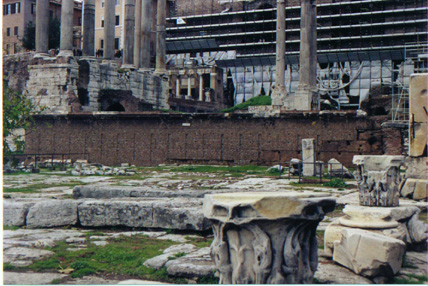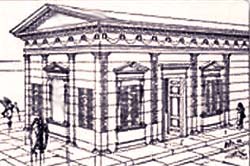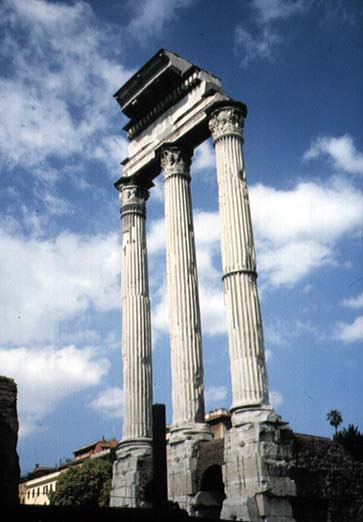The Roman Forum was the center for all of the official, legal, historical, and political events and hearings. It was mainly accessible by the road named the Via Sacra, and sits between the Capatoline and Palatine Hills, two of the seven hills in which Rome is built upon. it remained prominent for nearly 3 centuries until its final collapse when Christianity took place of the worship of dieties. It
The Regia was built by King Numa to house the important entities of Ancient Rome, their rulers, and later the Pontifex Maximus, or the High Priest. This Priest was responsible for the Roman Calendar and all types of records of the city, which were also stored inside the Regia. The structure had three rooms, one to hold the sacred shields of Mars, which, according to legend had fallen from the sky, along with what seems to be an alter to that specific God. Another room served as the temple for The Goddess Rhea, the patron God for the sowing of crops, in which only the Vestal Virgins and the Pontifex Mazimus could gain entry to. The Regia remained an important symbol to Rome, carrying throughout many generations, and with these generations it underwent numerous reconstructions. At one point, it was torn down completely and rebuilt on a different angle, as to keep it�s relationship with the House of the Vestals, which had previously burned down.
,
The Temple of Vesta, was built to honor its namesake Vesta, the Godess of the Hearth. It is here that her servants, known as the Vestal Virgins, carried out there duties. The most famous of these duties included tending the sacred Fire of Rome, making sure that it would never go out, as it would bring bad fortune upon the city. These priestesses were picked at the young ages between six and ten, and required to serve for 30 years, and stay true to their vow of Chastity. Ife they did break this vow, they were buried alive as not to bring the shame of the God�s. Once they had finished their term, they were allowed to live free lives, though few did so. These women who had such privileges as owning property, making wills and being buried inside the walls of the city.
,
The Priestesses lived in an 82-roomed palace known as the House of the Vestals. This structure, along with the temple, was banished once Theodosius outlawed all non-Christian cults.
,
The Curia served as the meeting place for the Roman Senate. This meeting hall underwent three reconstructions, starting as the Curia Hostilia, which was reconstructed by Sulla and then named Curia Cornelia, which was burned down and finally rebuilt by Diocletian under the current name of Curia Julia. Inside the one room stood the platform to seat the senate and the podium of it�s President, which was flanked b a statue of the Godess of Victory. The two statues The building was reconstructed in the 1930�s to resemble its earlier appearance, after it was converted into the church of St.Andriano.
,
The building of the Basilica Julia was initiated by Julius Caesar, though was finished by Augustus once Caesar had died. It served as an indoor-meeting for activities when weather was harsh. It underwent many reconstructions, both due to fire, and was finally destroyed on the sacking of the City. Little of it�s original structure stands.
,
The Rostra was where public speeches were held in the forum. It�s name comes from the decoration on it�s front, the image of the ships that lead Rome to Victory in the battle of Antium. It was moved to the main square by Julius Caesar. The front is still visible today.
,
The Temple of Antoninus and Faustina was built in honor of the emporor, Anoninus Pius, to honor the death of his wife Faustina. When he died later on, he was also commemorated in its dedication. Statues of the two rulers had once stood on the site of the temple, as indicated by their presence on Roman Coins, yet were smashed when the Christian Relegion was taking shape and the temple was sacked. It was converted into the church of St.Lorenzo, which helped keep it in such good Condition.
,
The Basilica Aemilia was named after it's creator, Marcus Aemilius Lepidus. It was the business area of Rome, housing many shops. The inner passages of the building were used for money changers and bankers.
,
The construction of the Basilica of Constantine was started my Maxentius and finished by Constantine, the last building added to the Roman Forum before the empire's final collapse. As Maxentius was in fact killed by Constantine in battle, Constantine then overtaking his rulership finished the Basilica, though changed its design in some points.It was one of the first buildings to have an entrance on the short side of the structure, something that only modern churches had. As all Basilicas were built for, it stood to house public affairs and court cases.
,
The Arch of Septimius Severus was erected to invoke pride in the Roman People of their Military Victories. It consists of three arches, the larger one topped with an inscription, once written out in Bronze Letters. Carvings and small pillars decorate its surface.
,
The Temple of Castor and Pollux was built to honor the two twin Gods who were reported to be helping the Roman side in a battle against the Estrucans. The supposed Gods were seen as two anonymous horseman joined in with the battle, and were said to be the two in disguis. The temple, (if you�ve noticed the trend, perhaps you can guess) burned down and was rebuilt by Tiberius. Only three of the outer supporting columns of this temple still stand. The temple was yet another meeting place for the senate, as well as a speakers platform.

|
|
Resources |










